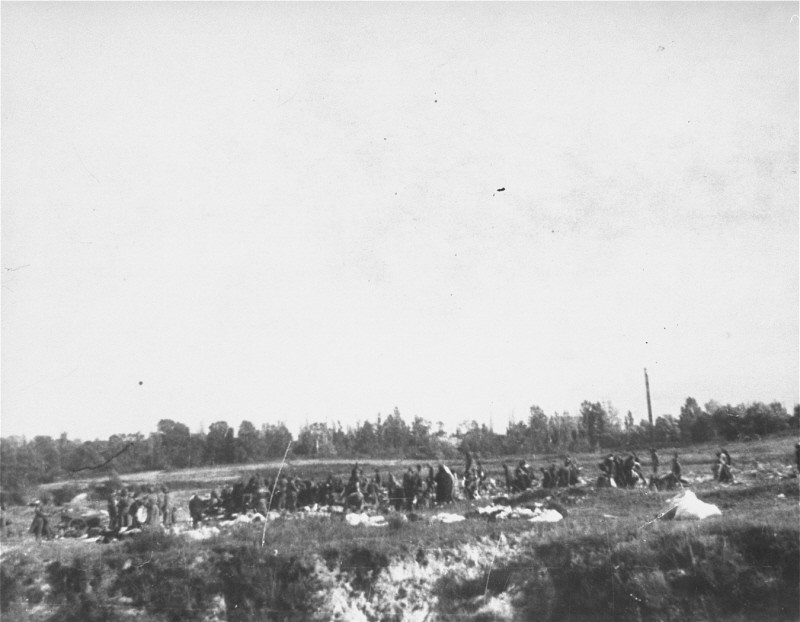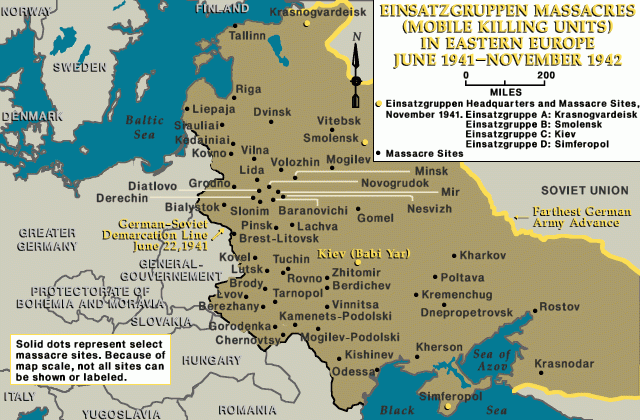
Einsatzgruppen and other SS and Police Units in the Soviet Union
The Einsatzgruppen were German special duty squads, composed primarily of SS and police personnel. The commanders and officers were also members of the Security Police and the Security Service. The units were directly subordinate to the Reich Security Main Office (Reichssicherheitshauptamt or RSHA) in Berlin and were to operate regionally in coordination with higher SS and police leaders. Ordered to follow the German army into the Soviet Union, the Einsatzgruppen were dependent upon the army for supplies and logistical support.
The Germans intended to fight an ideological war of annihilation in the Soviet Union. In line with this intent, RSHA chief Reinhard Heydrich instructed the Einsatzgruppe commanders to systematically kill civilians behind the front who were perceived to be "enemies" of Nazi Germany. The groups targeted for systematic murder included Jewish civilians, Roma (Gypsies), officials of the Soviet Communist Party and state apparatus, and anyone else they deemed politically or "racially" dangerous.
As the German army advanced deep into Soviet territory, the Einsatzgruppen followed the troops and implemented mass-murder operations. Supported by locally recruited police auxiliaries and other SS and German police units, the Einsatzgruppe personnel at first primarily shot Jewish men. In late July 1941, after the deployment of larger units of SS and police personnel in the occupied Soviet Union, these units, including the Einsatzgruppen, began to murder entire Jewish communities, including men, women, and children.
Four battalion-sized Einsatzgruppen and several police battalions were deployed in the occupied Soviet Union. Einsatzgruppe A fanned out from East Prussia across Lithuania, Latvia, and Estonia toward Leningrad. Its members massacred Jews in Kovno, Riga, and Vilna. Einsatzgruppe B set out from Warsaw in occupied Poland, and moved east through Belorussia towards Smolensk. Its members murdered Jews in Grodno, Minsk, Brest-Litovsk, Slonim, Gomel, and Mogilev, among other places. Einsatzgruppe C began operations from the Krakow area and headed across the Ukraine towards Kiev and Donetsk, massacring Jews and others in Lvov, Tarnopol, Zolochev, Kremenets, Kharkov, and Kiev. Einsatzgruppe D operated in southern Ukraine, extending the killings to the cities of Nikolayev, Kherson, Simferopol, Sevastopol, and Feodosiya.
By the spring of 1943, the Einsatzgruppen and other SS and police units had murdered more than a million Jews and tens of thousands of Soviet political officials, Roma, and disabled persons.

Among the most extensive massacres perpetrated by members of the Einsatzgruppen, along with SS and police personnel, was the systematic murder of 34,000 Jews at Babi Yar, a ravine to the northwest of Kiev, on September 29-30, 1941. Another massive operation was the murder of at least 25,000 Latvian Jews from the Riga ghetto in two short periods, November 30 and December 8-9, 1941.
In 1943, as the Germans began to retreat, special SS and police units, including Subdetachment (Teilkommando) 1005 under the command of SS officer Paul Blobel, sought to destroy all trace of mass shootings and gas van killings on occupied Soviet territory. SS and police personnel forced small groups of Jews to exhume bodies from the mass graves and cremate them. Once these grisly tasks were completed, the Germans shot the Jewish laborers in small groups, forcing each successive group to cremate the bodies of the group shot before them. The Germans continued this effort to eliminate the evidence of mass murder as the Soviet army liberated the Ukraine and Belorussia in 1943-1944.
Critical Thinking Questions
- What pressures and motivations may have affected these soldiers to volunteer for the Einsatzgruppen and later murder innocent civilians?
- Investigate what penalties there may have been for refusing to shoot Jews.
- Paramilitaries are often involved in mass atrocity. Why is that the case?

